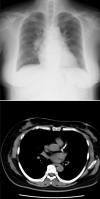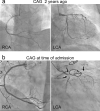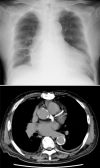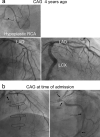Rapid decline in cardiac function in diabetic patients with calcified coronary artery disease undergoing hemodialysis: two case reports
- PMID: 34082711
- PMCID: PMC8173516
- DOI: 10.1186/s12872-021-02076-5
Rapid decline in cardiac function in diabetic patients with calcified coronary artery disease undergoing hemodialysis: two case reports
Abstract
Background: Clinical symptoms of patients on dialysis do not match the signs of coronary disease progression, making the prediction of the true progression of their medical condition in clinical settings difficult. Emergency and concomitant surgeries are significant risk factors of mortality following open-heart surgery in patients on hemodialysis.
Case presentation: We report two cases of successful coronary artery bypass grafting (CABG) in patients on dialysis with a history of cardiac surgery. The first case describes a 65-year-old woman who had undergone aortic valve replacement 2 years ago and was hospitalized urgently, because of a sudden decline in heart function and hypotension. She had moderate mitral regurgitation with right ventricular pressure of 66 mmHg and poor left ventricular function [left ventricular ejection fraction (LVEF), 40%]. Cineangiography revealed an increase in the rate of stenosis in the left main trunk, from 25 to 99% at admission, in addition to 100% occlusion in proximal left anterior descending artery (LAD) and 99% stenosis in the proximal left circumflex artery (LCX). We inserted an intra-aortic balloon pump preoperatively and performed emergency surgery (Euro II risk score, 61.7%; Society of Thoracic Surgeons (STS) risk score, 56.3%). The second case described a 78-year-old man who had undergone surgery for left atrial myxoma 4 years ago and was hospitalized urgently due to dyspnea, chest discomfort, and an LVEF of 44% (Euro II risk score, 40.7%; STS risk score, 33.2%). Cineangiography revealed an increase in the rate of stenosis in the proximal LAD, from 25% (4 years ago) to 90% at admission, in addition to 99% stenosis in proximal LCX and 95% stenosis in the posterolateral branch of LCX. Both patients underwent emergency CABG due to unstable hemodynamics and decreased left ventricular function despite regular dialysis. The surgeries were successful, and the patients were discharged without any complications.
Conclusions: In patients with multiple comorbidities and those who undergo dialysis treatment, calcified lesions in coronary arteries can progress severely and rapidly without any symptoms, including chest pain. Close outpatient management involving nephrologists and the cardiovascular team is necessary for patients on dialysis.
Keywords: Calcification; Coronary artery bypass grafting; Coronary artery disease; Diabetes mellitus; Hemodialysis.
Conflict of interest statement
The authors declare that they have no competing interests.
Figures







Similar articles
-
High-Output Cardiac Failure and Coronary Steal With an Arteriovenous Fistula.Am J Kidney Dis. 2018 Jun;71(6):896-903. doi: 10.1053/j.ajkd.2017.10.012. Epub 2017 Dec 23. Am J Kidney Dis. 2018. PMID: 29277506 Review.
-
Long-term Outcomes in Patients With Severely Reduced Left Ventricular Ejection Fraction Undergoing Percutaneous Coronary Intervention vs Coronary Artery Bypass Grafting.JAMA Cardiol. 2020 Jun 1;5(6):631-641. doi: 10.1001/jamacardio.2020.0239. JAMA Cardiol. 2020. PMID: 32267465 Free PMC article.
-
[Coronary artery bypass grafting in patients undergoing chronic hemodialysis: importance of wound healing and hypoproteinemia].J Cardiol. 2005 Feb;45(2):47-51. J Cardiol. 2005. PMID: 15768606 Japanese.
-
Effects of the side of arteriovenous fistula on outcomes after coronary artery bypass surgery in hemodialysis-dependent patients.J Thorac Cardiovasc Surg. 2014 Feb;147(2):619-24. doi: 10.1016/j.jtcvs.2013.01.031. Epub 2013 Feb 10. J Thorac Cardiovasc Surg. 2014. PMID: 23402689
-
Management of mild to moderate aortic stenosis at the time of coronary artery bypass grafting.J Heart Valve Dis. 2002 Jan;11 Suppl 1:S45-9. J Heart Valve Dis. 2002. PMID: 11843520 Review.
References
-
- Gürel OM, Demircelik MB, Bilgic MA, Yilmaz H, Yilmaz OC, Cakmak M, et al. Association between red blood cell distribution width and coronary artery calcification in patients undergoing 64-multidetector computed tomography. Korean Circ J. 2015;45:372–7. doi: 10.4070/kcj.2015.45.5.372. - DOI - PMC - PubMed
Publication types
MeSH terms
LinkOut - more resources
Full Text Sources
Medical

